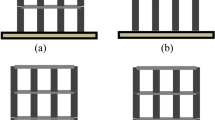Abstract
Performance-based seismic design offers enhanced control of structural damage for different levels of earthquake hazard. Nevertheless, the number of studies dealing with the optimum performance-based seismic design of reinforced concrete frames is rather limited. This observation can be attributed to the need for nonlinear structural analysis procedures to calculate seismic demands. Nonlinear analysis of reinforced concrete frames is accompanied by high computational costs and requires a priori knowledge of steel reinforcement. To address this issue, previous studies on optimum performance-based seismic design of reinforced concrete frames use independent design variables to represent steel reinforcement in the optimization problem. This approach drives to a great number of design variables, which magnifies exponentially the search space undermining the ability of the optimization algorithms to reach the optimum solutions. This study presents a computationally efficient procedure tailored to the optimum performance-based seismic design of reinforced concrete frames. The novel feature of the proposed approach is that it employs a deformation-based, iterative procedure for the design of steel reinforcement of reinforced concrete frames to meet their performance objectives given the cross-sectional dimensions of the structural members. In this manner, only the cross-sectional dimensions of structural members need to be addressed by the optimization algorithms as independent design variables. The developed solution strategy is applied to the optimum seismic design of reinforced concrete frames using pushover and nonlinear response-history analysis and it is found that it outperforms previous solution approaches.












Similar content being viewed by others
References
ACI (2008) Building code requirements for structural concrete (ACI 318–08) and commentary. American Concrete Institute, Farmington Hills
CEN (2000) Eurocode 2: design of concrete structures. Part 1–1: general rules and rules for buildings. European Standard EN 1992-1-1, Brussels, Belgium
CEN (2004) Eurocode 8: design of structures for earthquake resistance. Part 1: general rules, seismic actions and rules for buildings. European Standard EN 1998–1, Brussels, Belgium
Chan CM, Zou XK (2004) Elastic and inelastic drift performance optimization for reinforced concrete buildings under earthquake loads. Earthq Eng Struct Dyn 33:929–950
Deep K, Singh KP, Kansal ML, Mohan C (2009) A real coded genetic algorithm for solving integer and mixed integer optimization problems. Appl Math Comput 212:505–518
Fardis MN (2009) Seismic design, assessment and retrofitting of concrete buildings. Springer, Dordrecht
Fardis MN (2013) Performance- and displacemenent-based seismic design and assessment of concrete structures in fib model code 2010. Struct Concrete 14:215–229
FEMA (1997) NEHRP guidelines for the seismic rehabilitation of buildings. Federal Emergency Management Agency, Washington
fib (2003) Displacement-based seismic design of reinforced concrete buildings. Federation Internationale du Beton, Lausanne
fib (2012) Model Code 2010. Bulletins Nos. 65/66. Federation Internationale du Beton, Lausanne
Filippou FC, Ambrisi A, Issa A (1992) Nonlinear static and dynamic analysis of RC sub-assemblages. Report UCB/EERC-92/08. University of California, Berkeley
Fragiadakis M, Lagaros ND (2011) An overview to structural seismic design optimization frameworks. Comput Struct 89:1155–1165
Fragiadakis M, Papadrakakis M (2008) Performance-based optimum seismic design of reinforced concrete structures. Earthq Eng Struct Dyn 37:825–844
Ganzerli S, Pantelides CP, Reaveley LD (2000) Performance-based design using structural optimization. Earthq Eng Struct Dyn 29:1677–1690
Gencturk B (2013) Life-cycle cost assessment of RC and ECC frames using structural optimization. Earthq Eng Struct Dyn 42:61–79
Giberson MF (1967) The response of nonlinear multi-story structures subjected to earthquake excitation. PhD Thesis, California Institute of Technology, Pasadena, CA, USA
Holland J (1975) Adaptation in natural and artificial systems. University of Michigan Press, Ann Arbor
Kappos AJ, Stefanidou S (2010) A deformation-based seismic design method for 3D RC irregular buildings using inelastic dynamic analysis. Bull Earthq Eng 8:875–895
Krawinkler H (1996) Pushover analysis: why, how, when, and when not to use it. Proceedings 1996 SEAOC Convention, Maui
Lagaros ND (2014) A general purpose real-world structural design optimization computing platform. J Struct Multidisciplinary Optim 49:1047–1066
Lagaros ND, Fragiadakis M (2011) Evaluation of ASCE-41, ATC-40 and N2 static pushover methods based on optimally designed buildings. Soil Dyn Earthq Eng 31:77–90
MathWorks (2017) MATLAB R2017a – global optimization toolbox. The MathWorks Inc, Natick
Mergos PE (2017) Optimum seismic design of reinforced concrete frames according to Eurocode 8 and fib model code 2010. Earthq Eng Struct Dyn 46:1181–1201
Mergos PE (2018) Seismic design of reinforced concrete frames for minimum embodied CO2 emissions. Energ Buildings. https://doi.org/10.1016/j.enbuild.2017.12.039
Mergos PE, Kappos AJ (2012) A gradual spread inelasticity model for R/C beam-columns accounting for flexure, shear and anchorage-slip. Eng Struct 44:94–106
Panagiotakos TB, Fardis MN (1999) Estimation of inelastic deformation demands in multistorey RC frame buildings. Earthq Eng Struct Dyn 28:501–528
Panagiotakos TB, Fardis MN (2001) A displacement-based seismic design procedure of RC buildings and comparison with EC8. Earthq Eng Struct Dyn 30:1439–1462
Priestley MJN, Calvi GM, Kowalsky MJ (2007) Direct displacement based seismic design of structures. IUSS Press, Pavia
Reinhorn A, Roh H, Sivaselvan M, Kunnath SK, Valles RE, Madan A, Li C, Lobo R, Park YJ (2007) IDARC2D version 7.0: a program for the inelastic damage analysis of structures. MCEER-09-006 report. State University of New York at Buffalo, Buffalo
SEAOC (1995) Vision 2000, performance based seismic engineering of buildings. Structural Engineers Association of California, Sacramento
Sivaselvan MV, Reinhorn A (2000) Hysteretic models for deteriorating inelastic structures. J Eng Mech 126:633–640
Yang X (2014) Nature-inspired optimization algorithms. Elsevier Insights, London
Author information
Authors and Affiliations
Corresponding author
Additional information
Responsible Editor: Helder C. Rodrigues
Rights and permissions
About this article
Cite this article
Mergos, P.E. Efficient optimum seismic design of reinforced concrete frames with nonlinear structural analysis procedures. Struct Multidisc Optim 58, 2565–2581 (2018). https://doi.org/10.1007/s00158-018-2036-x
Received:
Revised:
Accepted:
Published:
Issue Date:
DOI: https://doi.org/10.1007/s00158-018-2036-x




